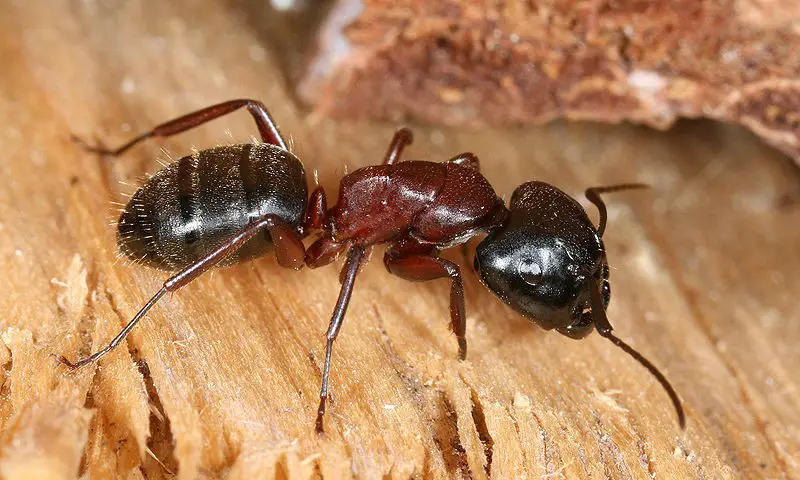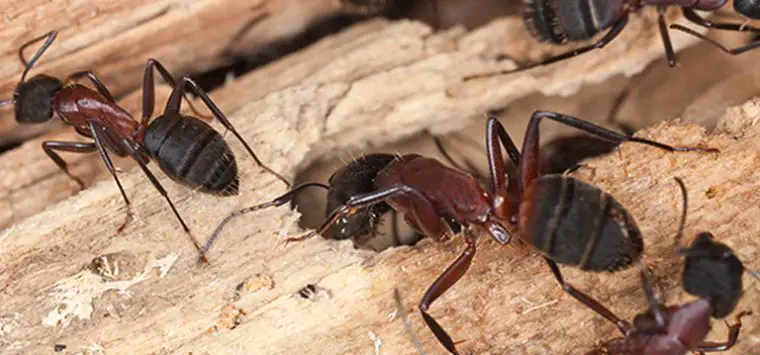How to save a tree from carpenter ants?
How to save a tree from carpenter ants?.
Sometimes the people confuse the need for a wood termite treatment with one for carpenter ants, a variety of ants listed as the largest, with black, reddish or yellow coloring and massive jaws.
Despite their name, they do not eat wood like termites. But that does not mean that they cannot produce significant material damage, because although they feed on the remains of people’s food such as sweets and meat, they do live and make galleries in the wood to live, which makes some people confuse them with termites. Therefore, it is essential to request the services of a pest control company to eliminate them as soon as possible, since the queen of these ants can lay 15 to 20 eggs the first year and double that number in the following years.
When they build their nests, they severely damage the wood, leaving behind the typical sawdust when they dig, which makes it easier to detect the nests. For this reason, and because in some cases they make satellite nests, it is essential to act as soon as possible and request an intervention similar to wood termite treatment.
In order to control a carpenter ant pest, it is necessary first to find its nest, and then apply select chemicals to eliminate both the queen ant and the rest. In addition, it should be noted that carpenter ants are often installed in woods with moisture problems, so to avoid further infestations of carpenter ants, these woods must be replaced or at least restored.
Signs of carpenter ants
The most typical indication of the presence of wood ants are piles of sawdust. It is also possible to observe ants’ legs or other parts of an ants body because wood ants continue to work diligently even if they lose a leg or a piece of their body. Usually, you notice them by finding a very fine sawdust on the floor near a window, a cupboard, or another wooden object.
Since wood ants don’t eat wood, they “nibble” it away and throw waste outside the nest. This explains the piles of sawdust.
Wood ants at work can also be heard. The nest can quickly grow very large and spread over different places. And all those little ant jaws working their way through the wood to build more tunnels and nests are obviously making noise. That’s the crackling sound you often hear.
Maybe you only see the tunnels and the damage the wood ants have done to the wood. Sometimes you can even see it on the outside, but most of the time, you will have to pry loose wooden planks to see the network of tunnels and the vast, hollowed-out openings where the wood ants lay their eggs.
How do you get rid of carpenter ants?

First of all, you have to be sure that they are wood ants. Then it would help if you tried to find out where their nest is. Look for ant tracks and see where the ants go when they drag food to their nest. Wood ants are often active at night. Then you will have to remove the rotten wood that the wood ants have eaten away. You will likely have to call in the help of a carpenter to repair the damage done.
How to get rid of carpenter ants in trees, methods
There are several methods of controlling ants. Are they:
Mechanical Control
This type of control is only possible when the anthill is still young. It consists of removing the nest by digging the site until you find the fungus pot (s) together with the queen. It is an effective control especially when the infested area is small.
Chemical Control
Chemical control can be carried out using granulated baits, dry powders, thermoset liquids or liquefied gases.
Granulated Baits
They are easy to use, consisting of small pieces of substrate (pellets) with substances very attractive to ants impregnated with a toxic active ingredient (insecticide). Its efficiency depends on the correct application and the efficiency of the active ingredient contained therein.
The most efficient baits are those that have a slow-acting active ingredient, as they do not kill ants by contact, allowing them to be carried into the anthill and distributed throughout the fungus.
The lures provide security for the applicator and allow the control to be carried out in areas of difficult access. During the application the baits must not be handled, as the ants will perceive strange smells and will reject them. Its use should not be carried out on rainy days and humid soils.
Dry powders
Formicide formulated in dry powders are applied directly inside the anthill by means of sprinklers (powder insufflation pumps). The application is more successful when done on dry land. Damp ground makes it difficult for the dust to penetrate. In very old nests, whose pans are usually very deep, the efficiency of this formulation is limited.
Thermobulizable Liquids
It consists of introducing liquid insecticide directly into the anthill’s scouts by means of devices that produce toxic smoke. The insecticide used must have fast action and act by contact. This method is expensive due to the equipment and specialized labor.
Liquefied gases
These are compressed gases in appropriate packaging that will be released directly into the eyes by means of hoses adapted to an outlet valve.
Fighting wood ants is not easy. In most cases, it’s a good idea to hire a professional pest repellent to prevent damage to your wood from taking on even higher proportions.
Preventive measures against carpenter ants
Once the wood ants have been fought, you must take a number of steps to ensure that they cannot come back:
- Make sure that spilled food or drink is cleaned up immediately. Leave food lying around, see ants as an invitation to pull up and join the buffet in droves.
- Remove damp and rotting wood. Wood ants love the moisture and the softer the forest, the more they like it.
- Do not pile wood near your house and prune the branches of trees and shrubs that hang too close to your home.
- Inspect your property and make sure that seams and cracks are closed.
- Remove debris that can be a safe hiding place for wood ants such as compost heaps, leaves, and other vegetation.
- Store food in tightly sealed containers.
References:
https://en.wikipedia.org/wiki/Carpenter_ant
https://extension.umn.edu/insects-infest-homes/carpenter-ants

